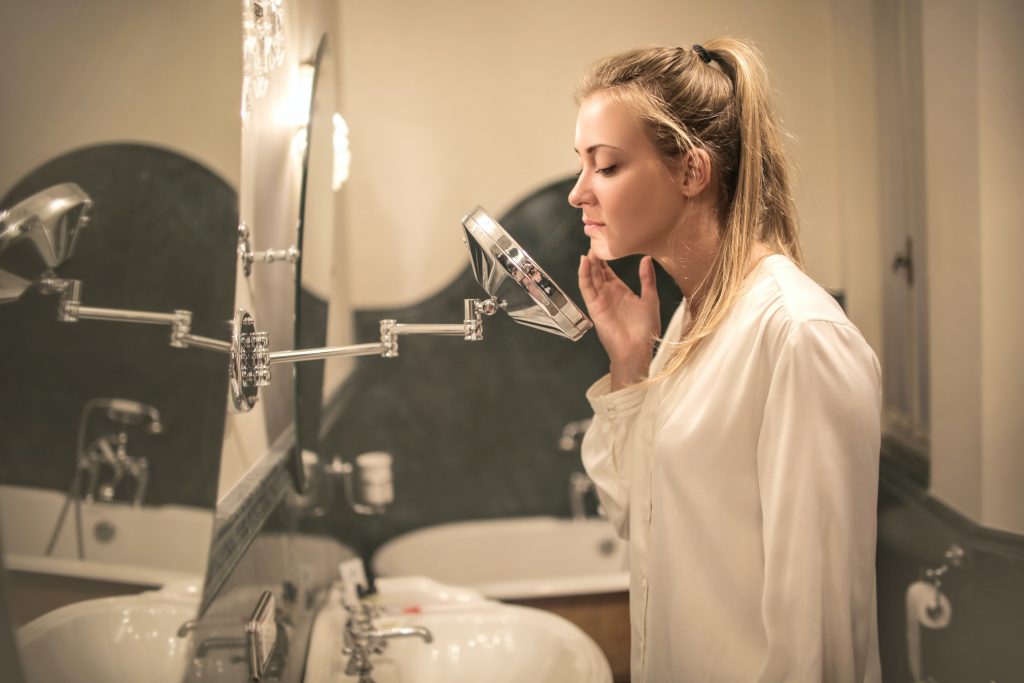It’s that time of the month again— constant cramping, moodiness, bloating— does it get any worse? As if these menstrual-related symptoms weren’t bad enough, now you’re beginning to experience a flare-up of blemishes during this time, hormonal breakouts, otherwise known as period acne. Oh, the joy of being a woman!
But, before you convince yourself that period acne is just another aggravating, non-negotiable side effect that comes with getting your menstrual cycle each month, think again! There are plenty of ways to maintain a healthy complexion during this time, but to do so, you must first learn about the integral relationship between your period and your skin.
Are you ready to crack the code on your hormonal breakouts and prevent future blemishes from occurring? Keep reading to learn how!
The science behind hormonal breakouts
Before you can start treating your hormonal acne, it’s important to first understand where your breakouts are stemming from. Sure, these bumps and blemishes relate to your menstrual cycle, but what exactly is happening to your body internally, that’s causing these impurities to appear on your skin?
The answer is quite simple; the science behind these types of breakouts relates to the hormonal imbalances that occur during this time. Specifically, the two hormones, estrogen, and progesterone. To explain the process of these fluctuating hormones, Elizabeth Gutrecht Lyster, MD., an OB/GYN at Holtorf Medical Group in Orange County, Calif tells WebMD:
“In the first half of a woman’s menstrual cycle, the predominant hormone is estrogen; in the second half, the main hormone is progesterone.” “Then levels of both hormones fall to their lowest levels of the month as bleeding approaches.”
Taking this into consideration, along with the fact that other existing male hormones remain constant in a woman’s body (in small amounts, of course), further helps to unravel why hormonal breakouts tend to occur. Male hormones such as testosterone appear to be more prevalent in a woman’s body during menstruation compared to other female hormones like estrogen.
With elevated testosterone levels comes more sebum production, or the thick oily substance that derives from the sebaceous glands in your body. In other words, as more sebum starts to produce, your body releases more oil, which can buildup in your skin and causes your pores to clog.
Hormonal breakouts vs. other acne types
Contrary to popular belief, experiencing acne during menstruation does not necessarily mean you’re dealing with hormonal-related breakouts. Although hormone fluctuations influence the majority of acne occurrences, it’s important to be mindful of how period acne can differ from other acne types.
Blackheads, whiteheads, papules pustules, etc.— can all occur for a variety of different reasons, including a poor diet, smoking, lack of sleep, bad hygiene, and other consequential lifestyle habits. That’s why it’s critical to recognize the differences between hormonal breakouts and other acne types, as this will help you better support the needs of your skin and determine which unique acne products are best for treating your blemishes.
One of the main differences between hormonal breakouts and other acne types is that hormonal breakouts, especially cysts, tend to appear on the chin or along the jawline. Even though this acne type may look insignificant on the surface, it can be extremely painful to the touch as they are deeper within the skin, unlike other acne types that are more oil trapped directly beneath the surface of the skin.
Because hormonal acne is more deeply penetrated in the skin, these breakouts can become redder and more inflamed when irritated, which is why popping your zits is a big no-no when dealing with this particular condition. Failure to do so can lead to further skin irritation, additional hormonal breakouts around the area, and even acne scarring! So, next time you go to pop those pesky cystic blemishes, remember the consequences it can have on the healing process.

How to treat hormonal breakouts
Luckily, there are many different treatment options when it comes to targeting hormonal breakouts. However, as previously mentioned, not all acne treatments are suitable for everyone, regardless of whether they share the same acne type concerns.
Some acne-fighting products may be better equipped for treating menstrual breakouts on a sensitive skin type, whereas others may be more beneficial for treating hormonal acne on an oily skin type. For this reason, identifying which skin type you resonate with most is necessary for your journey to clear complexion during your menstrual cycle, as this will make it easier to narrow down your search for a beneficial acne treatment for your skin.
Despite the distinctions in acne products available on the market, there are still a few common skincare ingredients to look out for on the product label that generally work best for treating hormonal acne during your menstrual cycle. That is retinoids, salicylic acid, and benzoyl peroxide.
Retinoids
Retinoids like tretinoin and adapalene are powerful ingredients in the world of skincare as it serves to adverse hormonal acne from the inside-out, which isn’t normally the case when compared to benzoyl peroxide and other acne-fighting ingredients. Specifically, retinoids work by seeping into the skin and binding to nuclear receptors that connect to overarching functions in your body, such as cellular metabolism, cell death, and inflammation. This helps to kickstart the turnover process of these functions and, therefore, speed up skin cell regeneration in your body and reduce the number of dead skin cells you have. In turn, your pores are more likely to remain clear and open, making it more receptive to retinoids and other topical acne treatments.
Salicylic acid
Another active ingredient that’s useful for treating period acne is a beta-hydroxy acid (BHA) known as salicylic acid. Similar to retinoids, this active ingredient also works to exfoliate dead skin cells by dissolving the bonds between the cells. Thus, preventing hair follicles from accumulating, clumping, and clogging our pores. Acne products with salicylic acid are also more effective for cleansing deeper into the skin because it is an oil soluble. Plus, salicylic acid is a precursor to aspirin, so it also comes with some anti-inflammatory benefits, which can be extremely useful when treating hormonal breakouts.
Benzoyl peroxide
Lastly, look for skincare products containing benzoyl peroxide. This ingredient acts to fight off acne-causing bacteria on the skin that promotes inflammation and contributes to the appearance of hormonal breakouts. Additionally, benzoyl peroxide removes blockages on the surface of the skin, which helps prevent pimples, pustules, and comedones (comedolytic), or the small pimples that arise on the skin. As if these anti-bacterial properties weren’t reason enough to use this ingredient on your hormonal breakouts, it also works faster than other skincare ingredients. Rather than having to wait weeks or months to notice a difference in your complexion, “most people can see results as early as five days,” says Arielle N.B. Kauvar, MD, of New York Laser Skin Care in an interview with Byrdie.
Talk with your doctor
Hormonal breakouts are no joke, especially when you’re already dealing with all the other symptoms that come from your menstrual cycle. Fortunately, period acne doesn’t have to be just another unpleasant part of menstruation. In addition to using this guide to overcome period acne, you should also be sure to talk with your doctor about different treatment options. Their professional skincare expertise is the best way to ensure you’re treating your skin with the right products and avoiding any potential irritation or inflammation from occurring.
Featured Photo by Polina Zimmerman from Pexels
